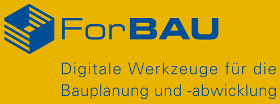FORBAU
RESEARCH ASSOCIATION VIRTUAL CONSTRUCTION SITE

BAUSIM
STATUS QUO
Until now, the term 'planning' has been used in the building sector purely from the point of view of statics and is restricted to drawing up the building schedule and project plans. What is generally missing is a dynamic alignment with the specific features/conditions of the construction project concerned and a detailed operations sequencing. In practice, this often creates bottlenecks caused by the inaccurate assessment of capacities. This in turn leads to delays in construction, which can only be overcome by investing a considerable amount of extra work and expense in order to meet the deadline for the completion of the project.
Another problematic aspect of the implementation phase is that there is no systematic, computer-assisted alignment between the actual progress made in construction and the scheduled stage of development in theory (target/performance analysis), resulting in highly time-consuming, labour-intensive work. This also applies to cost-controlling and on-site quality management. The manually collected data are inadequate for short-term control and are already out-of-date to a large extent by the time they are evaluated. So there is a permanent discrepancy between the time-line and the reality on the building site. It is therefore very difficult, if not impossible, in practice to realize a fast, up-to-date coordination of the construction processes.
THE AIM
The aim of this sub-project is to depict the whole sequence of development operations, from turning the first sod to completion, ahead of construction using virtual project planning. The core planning elements will be simulated in advance in order to validate the project planning and make adjustments, where required. In addition, the simulation model will be continually compared with the actual construction time and up-dated accordingly. The idea is to ascertain both the material flow and the performance on the building site and record them without delay in a central database (product data management or PDM system). It is also envisaged to complement development progress controls with up-to-date 3D models of the different construction phases, in order to reflect the actual situation on the building site as accurately as possible in the model.
PROJECT DESCRIPTION
The sub-project will accompany the entire construction process from the early planning phase to production on the building site, right up to the documentation of performance and quality-related data using standardized computer-aided tools, which will be aligned to the specific requirements of the construction planning and continually developed. The core elements of the research work, as indicated on the reverse side of this project sheet, are subdivided as follows.
Simulation of development processes
In the context of ForBAU, simulating the construction processes addresses the dynamic planning of operational sequences on the building site. To this end, software tools used in industrial material flow and factory planning will be adapted to the needs of the building sector during the course of the project, with a view to generating modular simulation models based on existing data records with relatively modest means. These data will be taken either from the site facilities plans (resources), for instance, the sub-soil model (such as soil quality by way of a time factor for excavation work), the model of the structure itself or, alternatively, from simulation modules to be developed specifically for structural engineering purposes. The essential interface is, of course, provided by the project plan, where the components of temporal dependence are first introduced. In view of the extremely high level of networking involved between the simulation and other disciplines, the safe, no-loss coupling of the simulation tool with the PDM system will be a priority aspect, since it is here that all the output data that are of relevance for the simulation, as well as the actual data from the building-site, are made available for the target/performance analysis.
Development of a building-specific PDM system
Due to the close meshing of the operations schedule and workflow simulation with the performance targets and actual data, as described above, developing a tailor-made PDM system designed specifically for building industry processes, based on standard, industrially available components, represents a key objective of the second sub-project. The aim is to illustrate all the relevant processes and participants, on the one hand, while simultaneously integrating the data formats that are commonly used nowadays in day-to-day construction practice in such a way that the vision of the universal use of data constitutes a main focus of the work.
Financial controlling of the building-site
In order to assess the whole sequence of development operations not only in terms of the construction time, but also with regard to financial considerations, a system of economic parameters will be established as part of this sub-project, based on standard construction processes. This will enable the project to be monitored from the point of view of both deadlines and monetary aspects.
Performance controlling on the building-site
The documentation and controlling of the performance levels attained on the building site represents another significant task for the second sub-project. Apart from monitoring construction machines with regard to their deployment times and the machinery data, particular importance is attached to geotechnical quality control. For example, quality-related documents relating to soil compaction through rolling (proof rolling), for instance, shall be recorded and archived in the centralized site information model. A further module in this context is three-dimensional surveying during construction, using unmanned aerial vehicles fitted with stereo-cameras and terrestrial laser scanning, designed to record development progress geometrically in the sense of a target/performance analysis.
Contact
Dipl.-Ing. Markus Schorr



